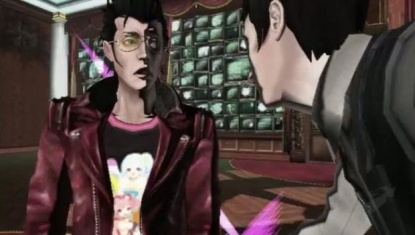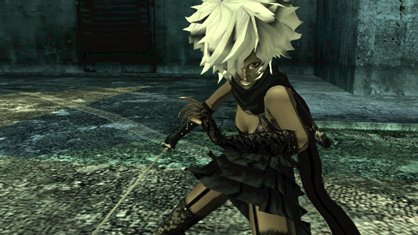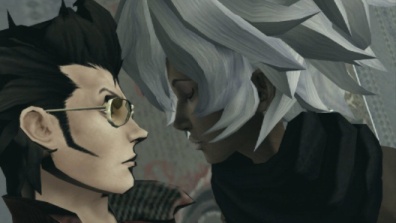
I'm approaching the end of No More Heroes 2, with a save right before the final ranked battle, with most of my stats maxed. I agree with the general criticism that it feels unfinished, especially with the lack of swords and the oh-so-brief playable segments with Shinobu and Henry (moreso Henry), but overall I think it's a better game than the first one. It's made me think of why I dig No More Heroes as a whole so much, despite so many of their flaws, and I think it's because they create a bridge across the Western/Eastern cultural divide in an entirely unique way.
It's no secret that Japanese console development is floundering, with their own market shrinking while the Western market is expanding. Still, it'd be a mistake to say that the Japanese should make games primarily for a Western audience. They might be able to look at the games we like and try to emulate them, but ultimately, they might not understand why we like the games we do.
As has been said many times before, looking at bits of other cultures is something like looking at American culture through a distorted mirror. Sometimes this works in favor, sometimes it...doesn't. But there are some examples which have strong Western influences which have gone over well in both territories, so let's take a look at a few series which accomplish this.
Capcom has excelled this generation because it's one of the few Japanese developers that really understands Western tastes. Look at Resident Evil - at first glance, there's really nothing that seems notably Japanese about it, since so much of it is based off Western horror movies in the first place. There are some incongruities, notably the awful voice acting and the cheesy dialogue from RE4, but these don't stand out all that much, considering that the zombie movie genre is already loaded with irony. Dead Rising is very similar in that regard, although I can't imagine a Western developer using anything like that game's timed structure or save system. And the same applies with Lost Planet, despite the main character being modeled after a Korean star. However, these all tip on one side of the scale though - they're almost too Western, I think.

On another topic - Metal Gear. Hideo Kojima has been in love with American cinema, something which has been obvious since his days working on Snatcher and the original Metal Gear. But the way he translates some of this influence into his games is completely hit or miss. For example, one of my favorite lines from Jeremy Blaustein, the game's translator, talks about how the names for the villains would sound totally ridiculous to a native English speaker. Kojima refused to change them. Blaustein admitted that the names ended up working, but not for the same reasons that they would in Japanese - "Decoy Octopus" sounds absurd, but that lends itself to the game's lovable goofiness. Kojima, however, he doesn't know where to draw the line between "adorably cheesy" and "just plain stupid". For instances of the latter, we point to "can love bloom on the battlefield?", the very concept of Rose, the whole node/nerd debacle, the President feeling Raiden up, Otacon's step-mom banging confession, and everything involved with that soda drinking monkey. I'm not sure how much of this is due to a cultural divide - the naming definitely is - and how much of it is just Kojima being an occasionally terrible writer, but in the end it's still weird and distracting. If Ryan Payton's task was truly to provide an American perspective on MGS4, then he did a pretty bad job of it.
And here's Grasshopper did such an outstanding job with No More Heroes - it combines the best of crazy Japanese artistic and game design sensibilities, but largely sidesteps the awkwardness that seems to come inherent with them.
As much as Western developers have picked up the slack this gen, the graphical styles are still notably uniform, and the soundtracks are the same way - they take too much from mainstream cinema. No More Heroes is the antithesis of that - it's got style in droves, and what's more, it manages to pull it off with some level of restraint, without devolving into the big-hair-big-swords excess that's become disparagingly associated with shounen anime (and JRPGs, for that matter.) Despite the fact that it still has ridiculously over-the-top villains with a just silly amounts of violence, it manages to find that nebulous balance where Kojima - and for that matter, the Final Fantasy games - really haven't.
The writing doesn't feel particularly foreign either - some of the minigames titles like Man the Meat, Lay the Pipe, Coconut Grabber and Getting Trashed are double entendres that only make sense in English, and it makes me wonder how they'll be translated into Japanese, if they are at all. When beginning any of the 8-bit minigames, you can hear Travis blowing into a cartridge - since the whole blinking fiasco with the NES was largely due to the system's lousy lock out chip, which didn't exist on the Famicom, I've always thought of this as a distinctly Western thing. (Might be wrong on this, though.) (I'm also going to be pedantic and say that the clicking noise when the cartridge is inserted doesn't sound enough like an NES.) And I don't know how they sound to a native Japanese, but in English, the names Santa Destroy and Travis Touchdown are pretty damned awesome. There's the Bizarre Jelly loli anime, of course, but all of that is very tongue-in-cheek and extremely self-deprecating.

The absolute perfect metaphor for this is Shinobu, the sole surviving boss from the first game (semi-spoiler: kind of) and a playable character in the second. Despite being a samurai influenced by Harajuku fashion sense (so super Japanese), she's also black (so very not Japanese at all), complete with an intensely stylized bright white afro. She represents a unification of two cultures, and is all the more awesome because of it.
There are still some missteps, though. The whole overworld in the first game seemed like an attempt to emulate GTA and the like, something which didn't really work out since it was so empty. And the peep show scenes in the second game, what with all of the closeups on the jiggling boobs and the panty shots, are uncomfortably voyeuristic. I'm not entirely sure I can explain the nature of America's sexual attitudes, although I'm going to try. A Japanese person might look at Lara Croft from Tomb Raider and wonder why that was OK but the bouncy girls in Dead or Alive are creepy. I think the answer, from an American perspective, is that we don't want it to be so overt. We like looking at girls in skimpy clothing, but we don't want it tossed in our faces, because such pandering makes us feel uncomfortable and guilty. (That might just be my Catholic upbringing, though.)
I find it curious how hugely the original No More Heroes flopped in Japan. Perhaps it was the result it feeling to Western? The line, the balance, is going to be different for everyone. Or perhaps it was just it being on the Wii - that's apparently what Marvelous felt, given that they're putting it out on the HD platforms in a few months. It would be interesting to hear what the Japanese think of it, at least.

Well, they DID warn us that Japanese developers would start foisting GTA clones on us. -__-
ReplyDeleteI never could have predicted what's happening now. Americans suddenly got sick of sequels? Jrpgs are hideously unpopular now? Without Megaman, Japan is lost? Wow.
I agree that the overworld in the first game could have been better, but I'd prefer they made a better overworld in the second game, rather than just tossing it out entirely. It makes the second game feel more bare. It especially sucks that aside from revenge missions which are available only at a select few points in the game, the only time you can fight is in the main game itself. You can't go on side missions to do stuff like play baseball against some guys or beat up guys using only wrestling moves or kill 100 guys in a row anymore. The only thing you can keep doing is each 8-bit minigame, and those don't offer enough gameplay to take the place of all the other stuff they could have put in/have taken out.
ReplyDeleteAn excellent post, Kurt. It still baffles me how Kojima went from the superb MGS3, with its emphasis on gameplay and compelling, relatively restrained story to the out-and-out excess of MGS4. The latter certainly stands as an example of the sort of choices Japanese developers seeking higher sales in the West should avoid. It's a somewhat dispiriting time for a certain type of gamer - those that grew up on Japanese games and never had much of a taste for western designs emphasizing First Person Shooting, Real Time Strategy, and such. You hit on something very important here - that a major appeal of Japanese games were their idiosyncratic natures, usually of fusion of simple gameplay, colorful, strikingly designed graphics and catchy, melodious music. Western games in contrast do tend to look alike; this is in itself rather ironic, when you consider other aspects of Japanese and Western society and the comparative emphasis on individuals versus the group.
ReplyDeleteI'm with you in that the one western genre I've really loved is the graphic adventure, the one that barely hangs on these days. Speaking of which, Kurt, any plans to do an article on early Japanese takes on the graphic adventure, like the Portopia Serial Murder Case, Jinguji Saburo series, and Famicom Detective Club? A Shadowgate article would also be welcome, especially to highlight the criminally unknown 'Beyond Shadowgate,' which has some of the best graphics on the Turbo Duo.
NMH sold poorly in Japan but so did all the other Suda51 games ( although Fatal Frame 4 should be the best selling in the series in Japan ).
ReplyDeleteI think the games he do aren't commercially viable in Japan because they cater to the western markets.
Also I believe that japanese gamers could see the crazy "nippon style" in Suda games like an offense to their culture ( akin to the fact that italian neo-realism was unsuccesfull in Italy because it depicted something about Italy that italians couldn't accept ) .
I want to add that western gamers start to know Grasshopper games with Killer7 and then NMH and those games despite strange and low budget were certainly better than Flower, Sun and Rain so maybe GHM early missteps alienated japanese gamers.
The opening titles to Game Center CX, a wholly Japanese show, features a kid blowing into a cartridge, so it's safe to say that was a universal thing.
ReplyDeleteI think NMH didn't sell in Japan perhaps because it was just too much inspired from american culture. It has this kind of "Tarantino" feel with caricatural japanese design which, i think, doesn't fit one with the other and nearly makes it insulting to the japanese but also to people who are fond of japanese culture.
ReplyDeleteJust like the anime "Afro Samurai", designed for western audience...
JohnH is right- blinking lights and related problems on the NES & Famicom are because of dirty contacts or loose pins.
ReplyDeleteHell I use to and still blow into Mega Drive carts...console voodoo man...it works.
ReplyDeleteI just wanted to second the fact that this is a great article...am I an ass because I think you represent yourself much better in print than on the HG podcasts I've heard?
ReplyDeleteAnyway, I love the blog and this article definitely has the brain cells churning. I am grateful for somebody speaking some truth on the ludicrous, in-my-opinion-game-ruining elements in MGS4. I bought a PS3 a few months ago and ranted on Kotaku a few threads worth of bile about my MGS4 experience, and was mostly cursed at by condescending yahoos who insisted that I didn't appreciate it because I lacked an appreciation of the series as a whole (or in one case - no lie - because I didn't appreciate our armed forces!). Bullshit! I think 1 and 3 were both excellent, they had their weird elements but they maintained a really unique atmosphere that gave the game its inimitable character. 2 was manageable. 4 was just mystifying in its misfired bombastic ramble. Michael Bay drunk, on acid, and translated to Japanese and back is how it ended up.
Sorry to ramble myself, but the contrast between the NMH games and MGS4 is stunningly apt - on the one side we have somebody who seems well-versed and bilingual in his use of counter-cultural concepts and imagery, and on the other we have someone who might have overestimated his comprehension of sophisticated Western narrative when attempting to merge it with homegrown elements. Both sought to produce a bicultural game experience that combined their sources in a meaningful way, and Suda emerges as the clear winner, albeit with a much smaller payday.
I did the whole "blowing into NES cartridges" thing for ages. Then I smartened up and simply cleaned the pins on all my carts and my NES, and they work wonderfully. I still get the lock-out troubles, of course, but it takes far fewer tries now to get a game to work.
ReplyDeleteI'd love playing NES games on my toploader model if (a) it supported composite, and (b) didn't have those funky vertical lines/distortions (which I hear is interference caused by some chip being too close to some wire or something—tech stuff is beyond me).
Anyhow, I adore the No More Heroes games. Two of my most favorite games to come out...well, ever. I love how they do mix Japanese and western culture—not just US and some European culture, but Mexican as well. The absurd over-the-topness of these games is so riveting, but I like how you say, Kurt, that it doesn't quite go into the COMPLETELY ridiculous anime/Japanese territory (...even though it does, ha ha), but presents it in such a way that's more acceptable I suppose to a lot of westerners who aren't into that sort of thing.
SUDA51 is such an idea man. I really like his creativity. killer7, the NMH series... I look forward to all future projects (and am slowly tracking down his past involvements as well; I must have his Blood+: One Night Kiss game).
There's a small, nagging feeling that I have about NMH2 is that Suda51, although pleased with the success of NMH in America, did not question American gamers on what quirks they liked about NMH.
ReplyDeleteFor me, it was all the little, useless flourishes that made NMH so cool. With NMH2, I feel like a kid on Christmas who gets a ton of loot, but not that Imperial AT-AT that he's been wanting all year. The absence of my favorite flourishes just leaves an empty space in my heart that was formally reserved for those girls in high school who didn't speak to me.
I think I remember reading somewhere that Suda51 wasn't as involved in NMH2 as the first one, so I accounted the differences for being the preference of another dude in charge. Personally, any of the small flourishes I missed in the first game were made up elsewhere in the second game, so I'm all good with it.
ReplyDelete